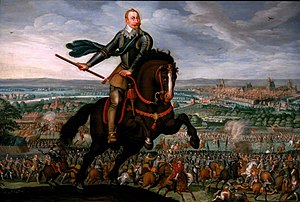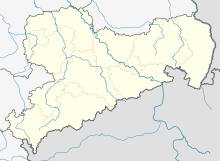| Battle of Breitenfeld | |||||||
|---|---|---|---|---|---|---|---|
| Part of the Thirty Years' War | |||||||
 Gustavus Adolphus at the battle of Breitenfeld, painting by J. J. Walther, 1632 painting in the Musée historique de Strasbourg. | |||||||
| |||||||
| Belligerents | |||||||
| Holy Roman Empire | |||||||
| Commanders and leaders | |||||||
| Strength | |||||||
40,150[1]
|
31,400[1]
| ||||||
| Casualties and losses | |||||||
|
5,550 |
16,600[note 1]
| ||||||
Location within Saxony | |||||||
The Battle of Breitenfeld (German: Schlacht bei Breitenfeld; Swedish: Slaget vid Breitenfeld) or First Battle of Breitenfeld (in older texts sometimes known as Battle of Leipzig), was fought at a crossroads near Breitenfeld approximately 8 km north-west of the walled city of Leipzig on 17 September (Gregorian calendar), or 7 September (Julian calendar, in wide use at the time), 1631.[b][a] A Swedish-Saxon army led by King Gustavus Adolphus of Sweden and Saxon Elector John George I defeated an Imperial-Catholic League Army led by Generalfeldmarschall Johann Tserclaes, Count of Tilly. It was the Protestants' first major victory of the Thirty Years War.
Sweden entered the Thirty Years' War in 1628 in an attempt to prevent the Holy Roman Emperor Ferdinand II from expanding his power to the Baltic Sea and threaten Swedish territory. King Gustavus Adolphus landed with a Swedish army in the Duchy of Pomerania in 1630 to intervene in favor of the German Protestants. In the spring of 1631, Field Marshal Tilly had assembled an army to restore Imperial control over northern Germany. Already that summer, Tilly invaded the Electorate of Saxony, whose Elector John George I chose to enter into an alliance with Gustavus Adolphus. With their united troops totalling 40,150 men, the Protestant armies marched to Leipzig to meet Tilly's army, which numbered 31,400 men.
The three armies met outside the village of Breitenfeld in early September 1631. At the start of the battle, the Saxon army was knocked off the battlefield by the imperial cavalry, whereupon Tilly with his infantry tried to engage the Swedish army with a pincer movement. Through quick improvisation and the flexibility and firepower among the Swedish troops, they were able to regroup and launch a series of counterattacks against Tilly's troops. When Gustavus Adolphus performed a broad counteroffensive with his cavalry, Tilly was forced to retreat from the battlefield, losing two-thirds of his army after the battle.
The Swedish-Saxon victory at Breitenfeld allowed Gustavus Adolphus to launch a campaign against southern Germany. It was the King's most notable military victory and cemented his reputation of being one of the greatest military commanders in modern history.[6] His army at Breitenfeld utilized an early form of combined arms and mobile units, combined with superior discipline, organizational flexibility and initiative. As the war progressed, several armies, including the imperial army, began to adopt the Swedish military doctrine.
Cite error: There are <ref group=lower-alpha> tags or {{efn}} templates on this page, but the references will not show without a {{reflist|group=lower-alpha}} template or {{notelist}} template (see the help page).
- ^ a b c Cristini 2017, p. 100.
- ^ Mankell 1854, p. 496.
- ^ a b Åselius & Wolke 2003, pp. 119, 128.
- ^ a b c Gullberg 2008, p. 108.
- ^ § Casualties
- ^ Williamson 1988, p. 128.
Cite error: There are <ref group=note> tags on this page, but the references will not show without a {{reflist|group=note}} template (see the help page).

